Media
For media enquiries regarding my work please see the details on my contact page
Press releases associated with my work are listed below
-
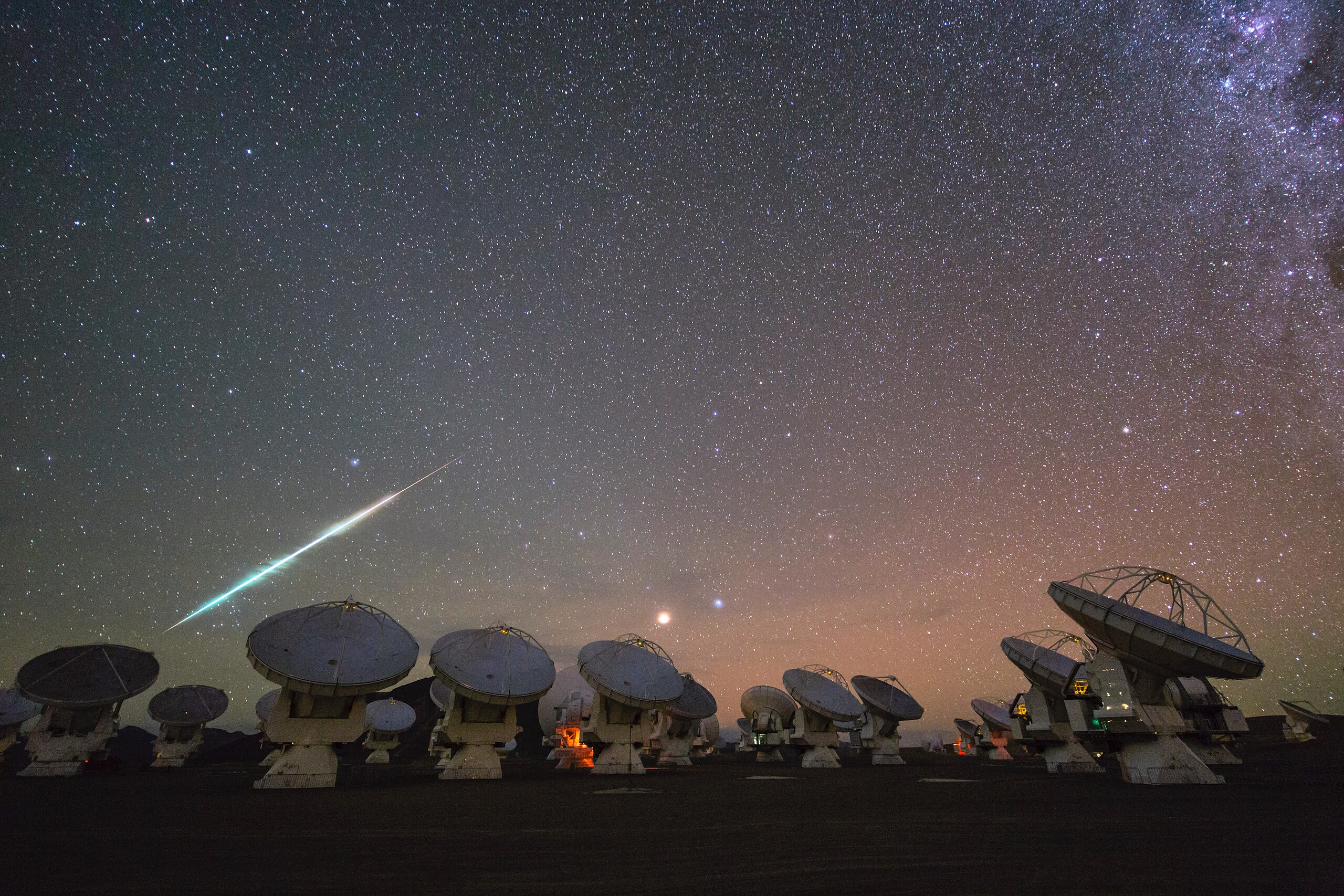
Research paper:
Seismic and acoustic signals from the 2014 ‘interstellar meteor’,
authors Benjamin Fernando, Pierrick Mialle, Goran Ekstrom, Constantinos Charalambous, Steven J. Desch, Alan P. Jackson, Eleanor K. SansomPublished in Geophysical Journal International, June 2024
Conference abstract:
Probably Not Aliens — Seismic Data Analysis from the 2014 'Interstellar Meteor',
authors Benjamin Fernando, Constantinos Charalambous, Steven J. Desch, Alan P. Jackson, Pierrick Mialle, Eleanor K. Sansom, Goran EkstromPresented at Lunar and Planetary Science Conference, March 2024
Press release by Johns Hopkins University
This was covered quite widely in the press, including Scientific American, New York Times, Mashable, Newsweek, and Washington Post
Sound waves thought to be from a 2014 meteor fireball north of Papua New Guinea were almost certainly vibrations from a truck rumbling along a nearby road, new Johns Hopkins University–led research shows. The findings raise doubts that materials pulled last year from the ocean are alien materials from that meteor, as was widely reported.
Image credit: ESO/C. Malin
-
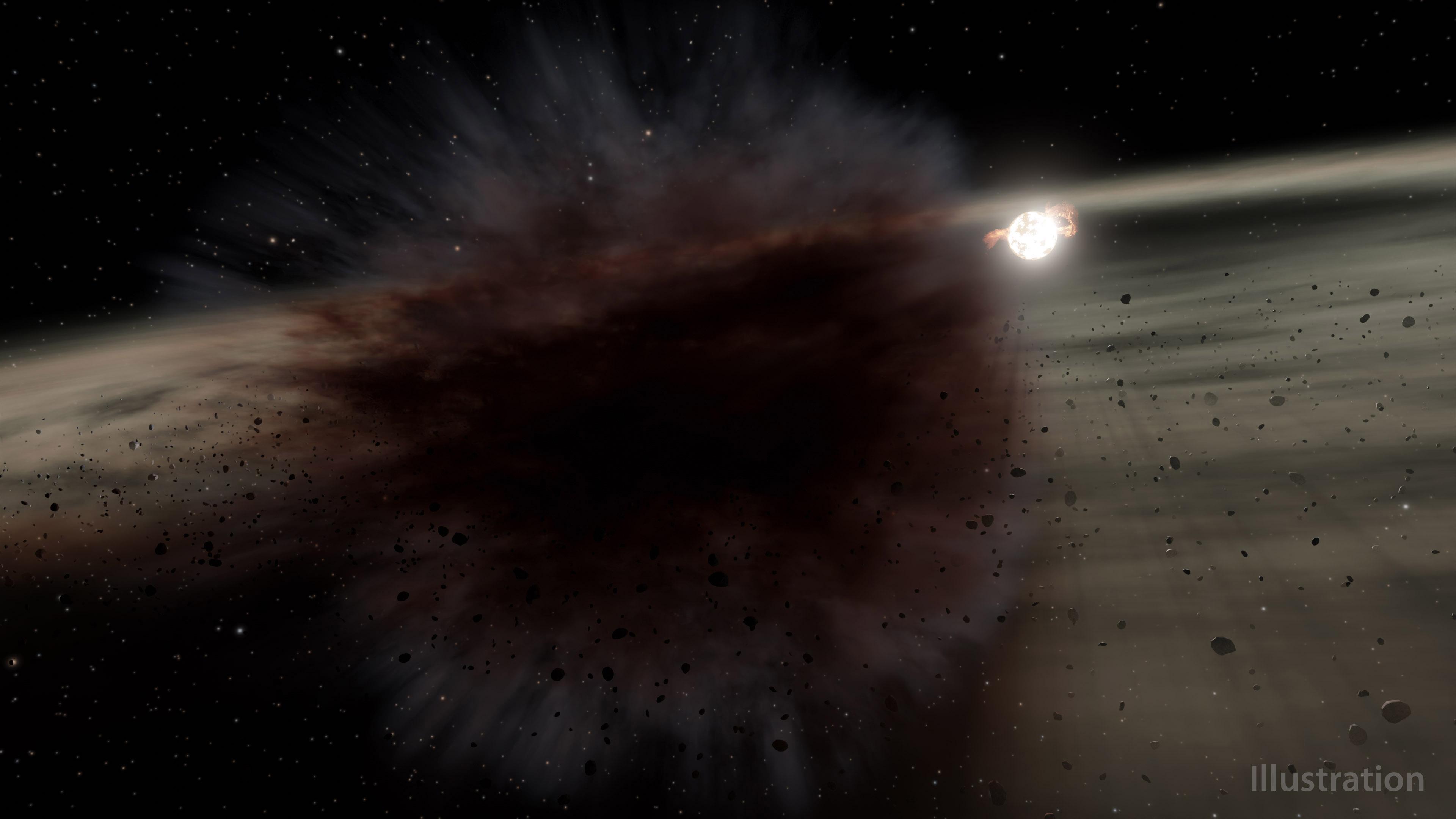
Research paper:
Carbon monoxide gas produced by a giant impact in the inner region of a young system,
authors Kate Y.L. Su, Grant M. Kennedy, Everett Schlawin, Alan P. Jackson, George H. RiekePublished in The Astrophysical Journal, March 2022
Press releases by University of Arizona and NASA/JPL
This was covered quite widely in the press, including CNN, CTV News, Fox News, and Frankfurter Neue Presse
Most of the rocky bodies in our solar system, including Earth and the moon, were formed or shaped by massive collisions early in the solar system's history. By smashing together, the bodies might accumulate more material, increasing in size and potentially forming planets. The bodies might also lose material, but in the process, satellites like the moon could form.
In this study we report five years of observations of the young, nearby star HD 166191 with the now-retired Spitzer Space Telescope. We found that the system got significantly brighter in the infrared around the middle of 2018, suggesting an increase in dust production due to one of these violent, planet-forming events. For the first time, we also saw the debris cloud pass in front of the star, blocking some of its light for a short time, which allowed us to directly determine the size of the cloud shortly after the impact, and estimate the size of the objects involved.
Image credit: NASA/JPL-Caltech
-
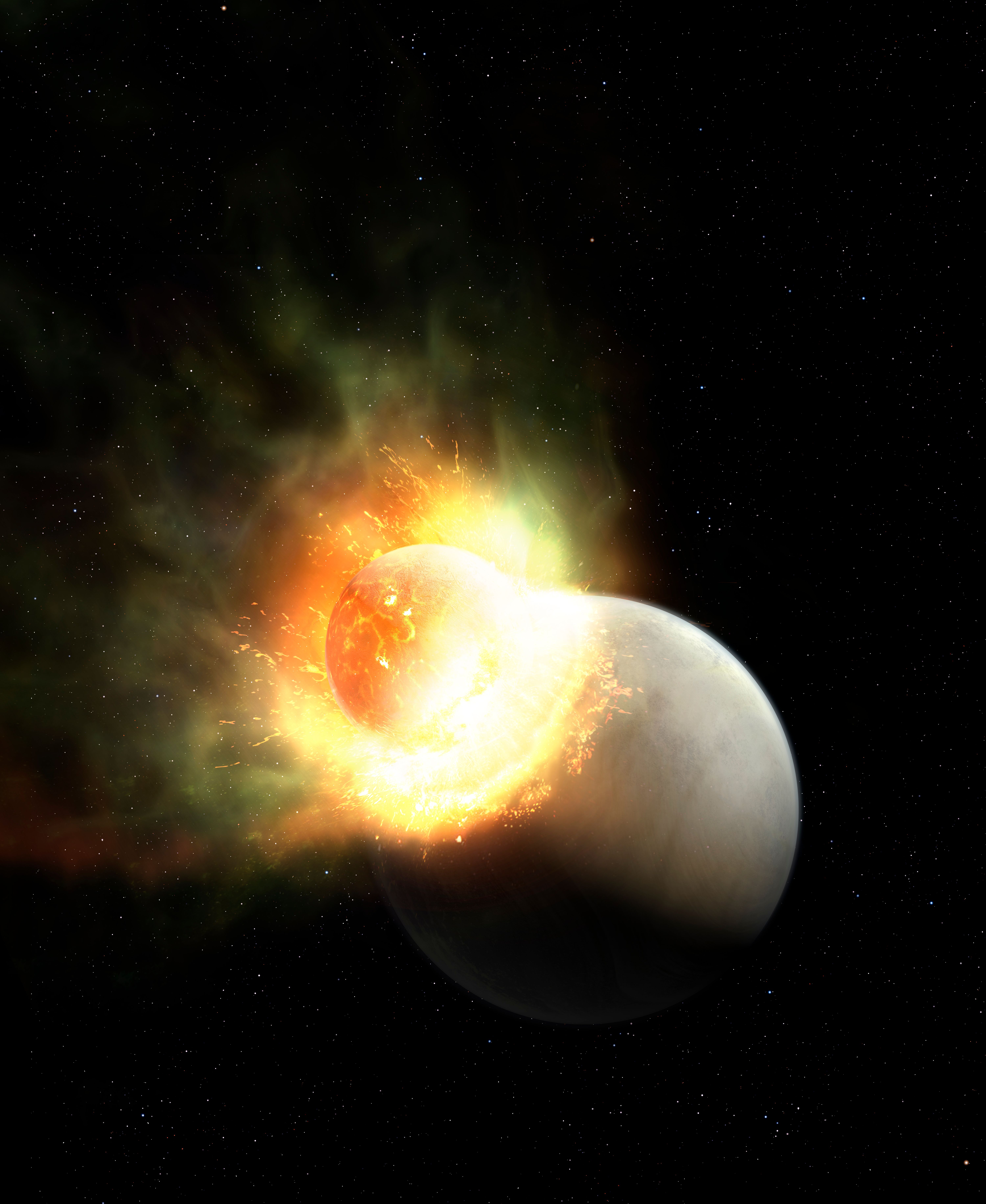
Research paper:
Carbon monoxide gas produced by a giant impact in the inner region of a young system,
authors Tajana Schneiderman, Luca Matrà, Alan P. Jackson, Grant M. Kennedy, Quentin Kral, Sebastián Marino, Karin I. Öberg, Kate Y. L. Su, David J. Wilner and Mark C. WyattPublished in Nature, October 2021
Press release by Massachusetts Institute of Technology
The final stage of the growth of terrestrial planets is widely thought to be violent, involving giant impacts between planet-sized bodies. In our own Solar System the Moon is believed to be a product of such an impact. These giant impacts should be common in young star systems that are undergoing terrestrial planet formation, but they have been difficult to observe.
In this study we report the detection of carbon monoxide gas in the inner, terrestrial region of the nearby star system HD 172555 using observations obtained on the Atacama Large Millimetre/sub-millimetre Array (ALMA). Carbon monoxide has a very low freezing temperature, and is slowly destroyed over time by ultraviolet light from the star, so to find it in a system like HD 172555, which is about 23 million years old, it cannot have been there since the system was born, but must have been produced more recently. There is no sign of dust or gas in the outer parts of the system, so the source of the carbon monoxide must be in the inner parts of the system.
After examining all of the possibilities, we concluded that it is most likely that the carbon monoxide gas is the result of a Venus-like planet with a thick atmosphere undergoing a giant impact at least 200,000 years ago that blew off part of the atmosphere.
Image credit: Mark A. Garlick/ markgarlick.com
-
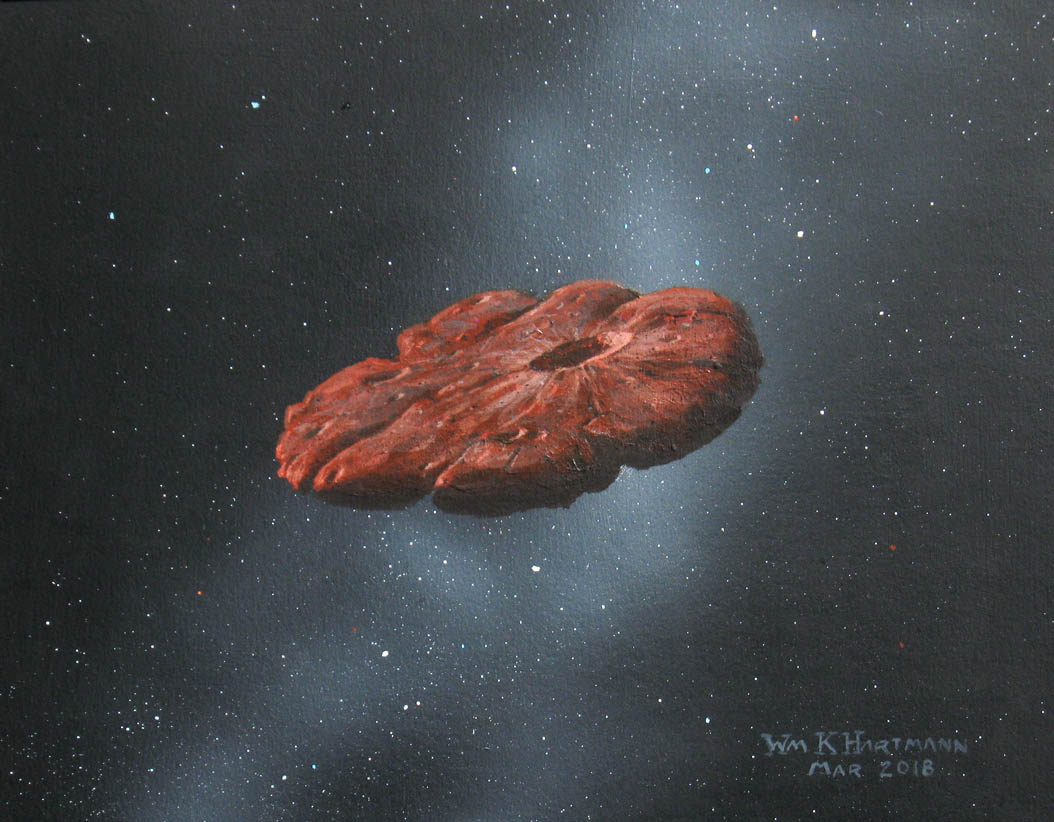
Research papers:
1I/'Oumuamua as an N2 ice fragment of an exo‐Pluto surface I: Size and Compositional Constraints,
authors Alan P. Jackson and Steven J. Deschand 1I/'Oumuamua as an N2 ice fragment of an exo‐Pluto surface II: Generation of N2 ice fragments and the origin of 'Oumuamua,
authors Steven J, Desch and Alan P. Jackson,Published in Journal of Geophysical Research: Planets, March 2021
Press releases by Arizona State University and the American Geophysical Union
Video summary produced by the Arizona State University School of Earth and Space Exploration
This work was widely covered in the press, including in print at The Associated Press, The Guardian, CNN, and The BBC; on radio at CBS News Radio LA, and the BBC World Service; and on television at Al-Jazeera English.
This work was identified as the top story of 2021 for the College of Liberal Arts and Sciences at Arizona State University
The first confirmed interstellar object, 1I/'Oumuamua was discovered on 19th October 2017 by the Pan-STARRS 1 telescope at Haleakala Observatory in Hawai'i. It had long been expected that comets of interstellar origin should exist, since we know that comets are thrown out of our own Solar system, but finding the first object of interstellar origin was nonetheless very exciting, especially so as it did not match our expectations.
We had expected interstellar objects to be comets, since the majority of bodies ejected from the Solar system today are comets, and indeed the second interstellar object discovered, 2I/Borisov, matches this expectation. In contrast, observations of 'Oumuamua did not detect a cometary tail, giving the impression that it was an object that lacked volatile ices, more like an asteroid rather than a comet, leading many people including myself, to investigate scenarios in which a larger number of asteroid-like objects might be ejected than we believe happens in our Solar system. Additional observations later in 2018 by Micheli et al. however revealed a small deviation in the orbit of 'Oumuamua from a purely ballistic trajectory. Deviations like this are often seen for comets as a result of the gases sublimating off the surface giving them a small push away from the Sun, but since we had not detected a tail of sublimated gases from 'Oumuamua so this was puzzling.
In addition, 'Oumuamua has an unusual shape. Initial analysis of the rotational light curve of the object suggested a cigar-shaped object around 8 times as long as it was wide. This was later refined, suggesting it was more likely a disk-shaped object about 6 times as wide as it was thick, but nonetheless this is still significantly more extreme than any known Solar system object.
Our new work provides an explanation for all of the unusual features of 'Oumuamua as naturally arising if it is composed of nitrogen ice, a substance that is commonly found in the outer solar system on the surfaces of bodies like Pluto and Triton. A nitrogen-ice body would undergo significant erosion as it passed through the Solar system, losing around 95% of its mass. The nitrogen gas released as the ice sublimated would accurately reproduce the observed non-gravitational acceleration. Moreover, the erosion of material from the outer surface of the body leads to an increase in the axis ratio over time, much as a bar of soap is slowly worn down to a thin sliver through much use. In addition, the reflectivity at which the observed properties of 'Oumuamua are reproduced matches that observed for the surface of Pluto.
Image credit: Painting by William K. Hartmann, based on commission from Michael Belton
-
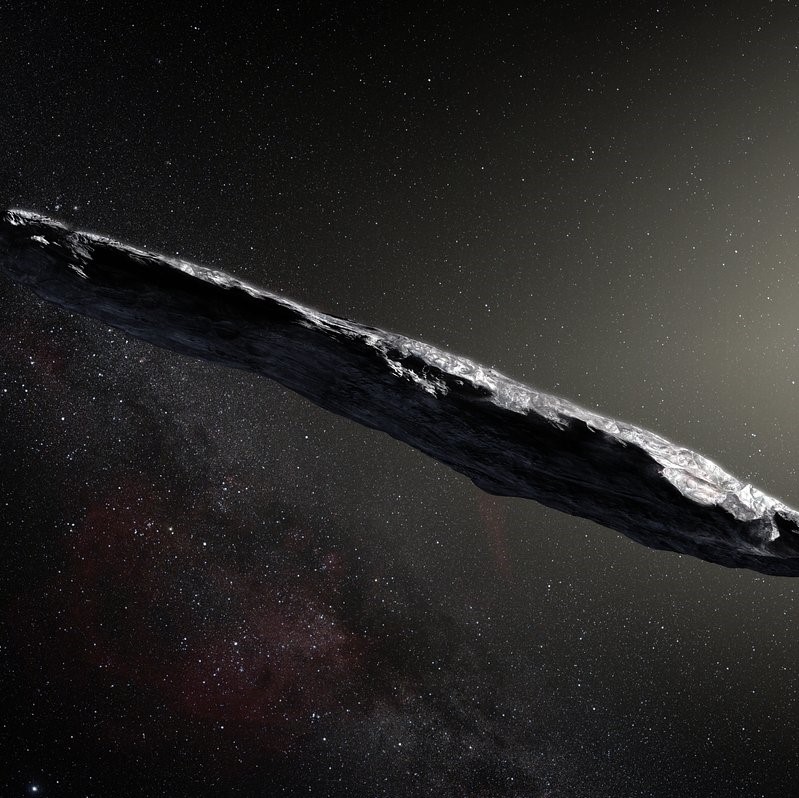
Research paper:
Ejection of rocky and icy material from binary star systems: Implications for the origin and composition of 1I/'Oumuamua,
authors Alan P. Jackson, Daniel Tamayo, Noah Hammond, Mohamad Ali-Dib, Hanno Reinpublished in Monthly Notices of the Royal Astronomical Society: Letters, March 2018
Press releases by the University of Toronto, and the Royal Astronomical Society
This was covered quite widely in the press, including The Associated Press, CBC News, The Guardian, and The Daily Mail
Original content:
Discovered on 19th October 2017 by the Pan-STARRS 1 telescope at Haleakala Observatory in Hawai'i, 'Oumuamua is an intriguing object. With an eccentricity of 1.2 and travelling at around 26 km/s relative to the Solar system it is the first confirmed body of interstellar origin to pass through the Solar system. In addition it is highly elongated, as can be seen in the artist's impression, and has displayed no detectable coma or tail-like activity, despite having passed within 0.25 AU of the Sun (within the orbit of Mercury), making it a volatile-poor asteroid rather than an ice-rich comet. It was this latter point that particularly interested me and my colleagues at the University of Toronto.
The overwhelming majority of objects that are ejected from our own Solar system out into interstellar space are icy comets that originate from the outer regions like the Kuiper belt, not the inner parts of the Solar system where rocky asteroids are found. This is because the dominant contributors to ejecting material from the Solar system are Neptune and Jupiter, which are themselves in those outer regions. To be more efficient at ejecting material from the warm, inner regions we need a system with a different architecture to ours, one that has a large body in the inner regions. A Jupiter like planet in the inner parts of the system would work, but planet surveys have told us that Jupiter-like planets close to their parent stars are not very common. Binary stars on the other hand are common, with something like half of all stars being members of a binary or multiple star system. Moreover the companion star is there right from the very beginning of the life of the system, so material can start being ejected as soon as planetesimals form, rather than having to wait until a large planet can be formed. As such we found that material ejected from binary stars should dominate the population of interstellar bodies, especially for rocky ones like 'Oumuamua, which then means that 'Oumuamua most likely was born in a binary star system.
Update:
Further work later in 2018 by Micheli et al. showed that matching the trajectory of 'Oumuamua through the solar system required a comet-like non-gravitational acceleration, suggesting that 'Oumuamua might actually be a comet rather than a volatile-poor asteroid. See our more recent press release above for a more up-to-date hypothesis for this interesting object.
Image credit: ESO/M. Kornmesser, artist's impression of 1I/'Oumuamua
Image Credit: ESO/M. Kornmesser, artists impression of 1I/'Oumuamua